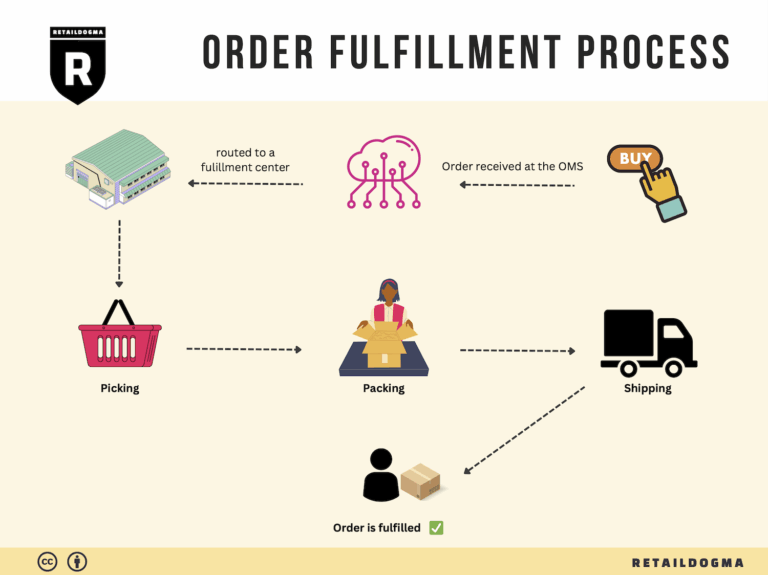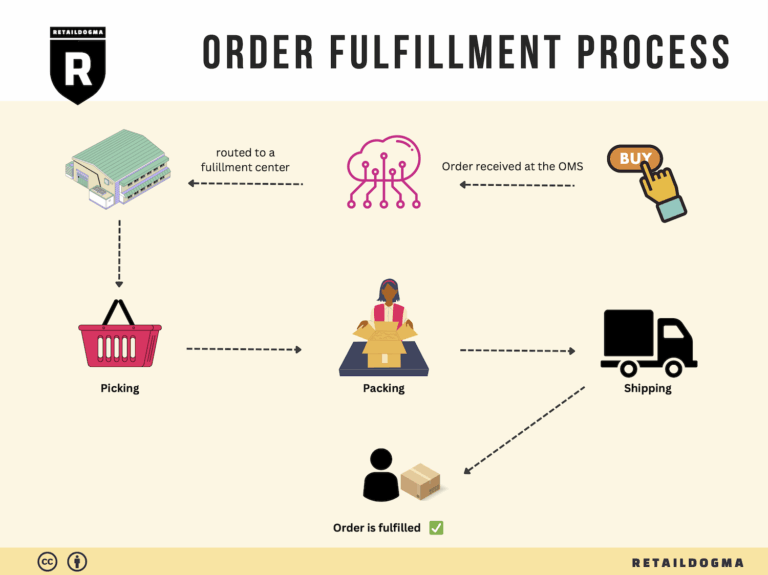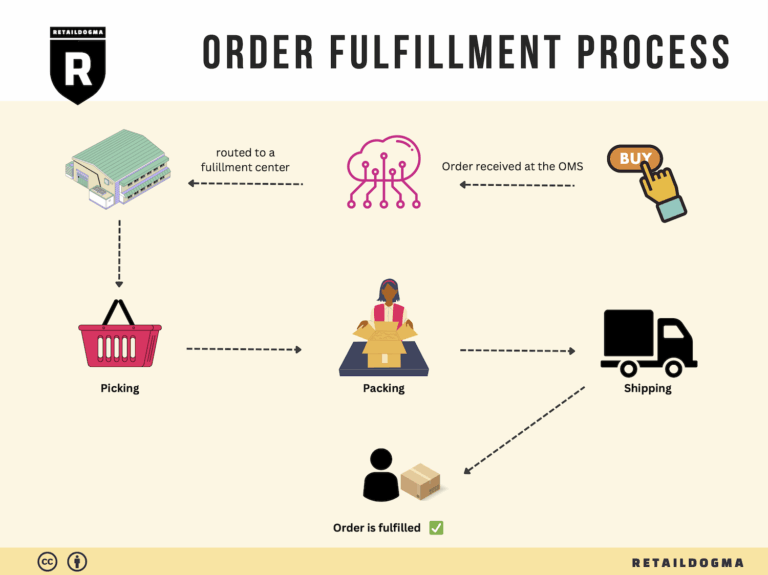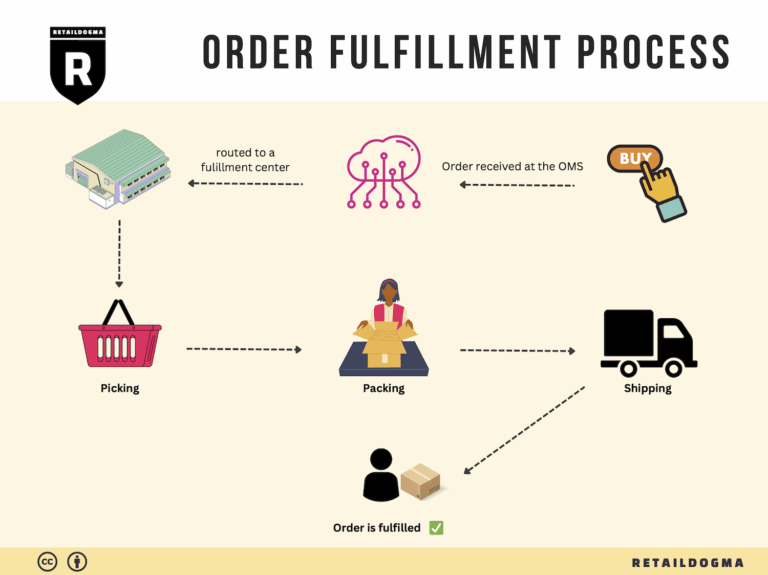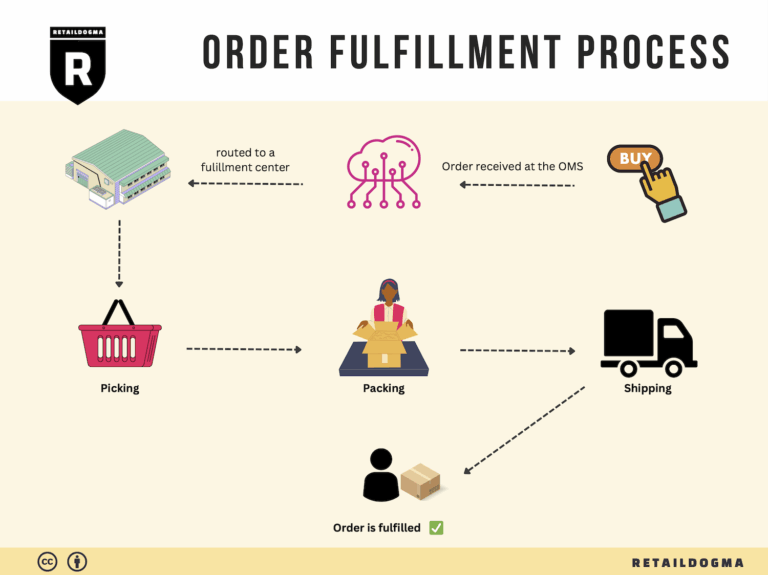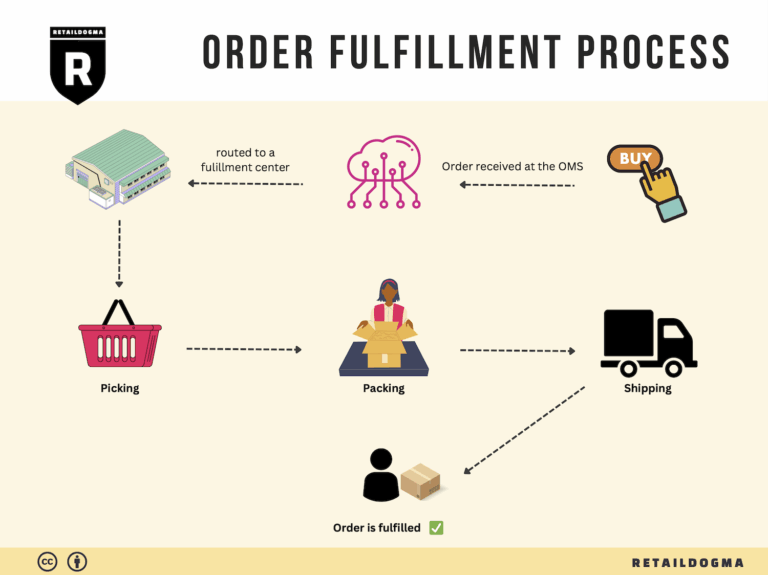What Is A Fulfillment Center? A Complete Guide (2025)
What is E-commerce Fulfillment? An Introduction for Growing Businesses
Understanding E-commerce Fulfillment
As an e-commerce business owner, you may find yourself grappling with the daunting task of packing and shipping orders—an overwhelming responsibility that can detract from your core mission: growing your business. This is a common pain point for many entrepreneurs, especially as sales increase and operational complexities multiply. Managing logistics can quickly consume valuable time and resources that could be better spent on marketing, product development, or customer engagement.
So, what exactly is e-commerce fulfillment? At its core, fulfillment is the process of getting a product from your inventory to your customer’s doorstep. This encompasses a variety of tasks, including inventory management, order processing, packing, shipping, and handling returns. Each step plays a vital role in ensuring that customers receive their orders accurately and on time, which is essential for maintaining high satisfaction levels and repeat business.
This guide will explore the various facets of e-commerce fulfillment, providing you with a comprehensive understanding of how to streamline this critical aspect of your operations. We will delve into different fulfillment models, such as Third-Party Logistics (3PL) and Fulfillment by Amazon (FBA), examining their advantages and how they can align with your business goals.
Additionally, we will outline the core services involved in the fulfillment process, including warehousing, order picking, packing, shipping, and returns management. Understanding these services will help you identify what you need as you scale your operations.
Choosing the right fulfillment partner is crucial for your success. We will discuss key considerations to keep in mind when selecting a fulfillment provider, including technology integration, customer support, and flexibility to adapt to your business’s growth.
Lastly, we will cover pricing structures and what to expect in terms of costs associated with fulfillment services. This information will empower you to make informed decisions that positively impact your bottom line.
Ultimately, this guide aims to equip you with the knowledge needed to navigate the complex landscape of e-commerce fulfillment confidently. By making smart logistics decisions, you can enhance operational efficiency, improve customer satisfaction, and drive your business’s growth trajectory.
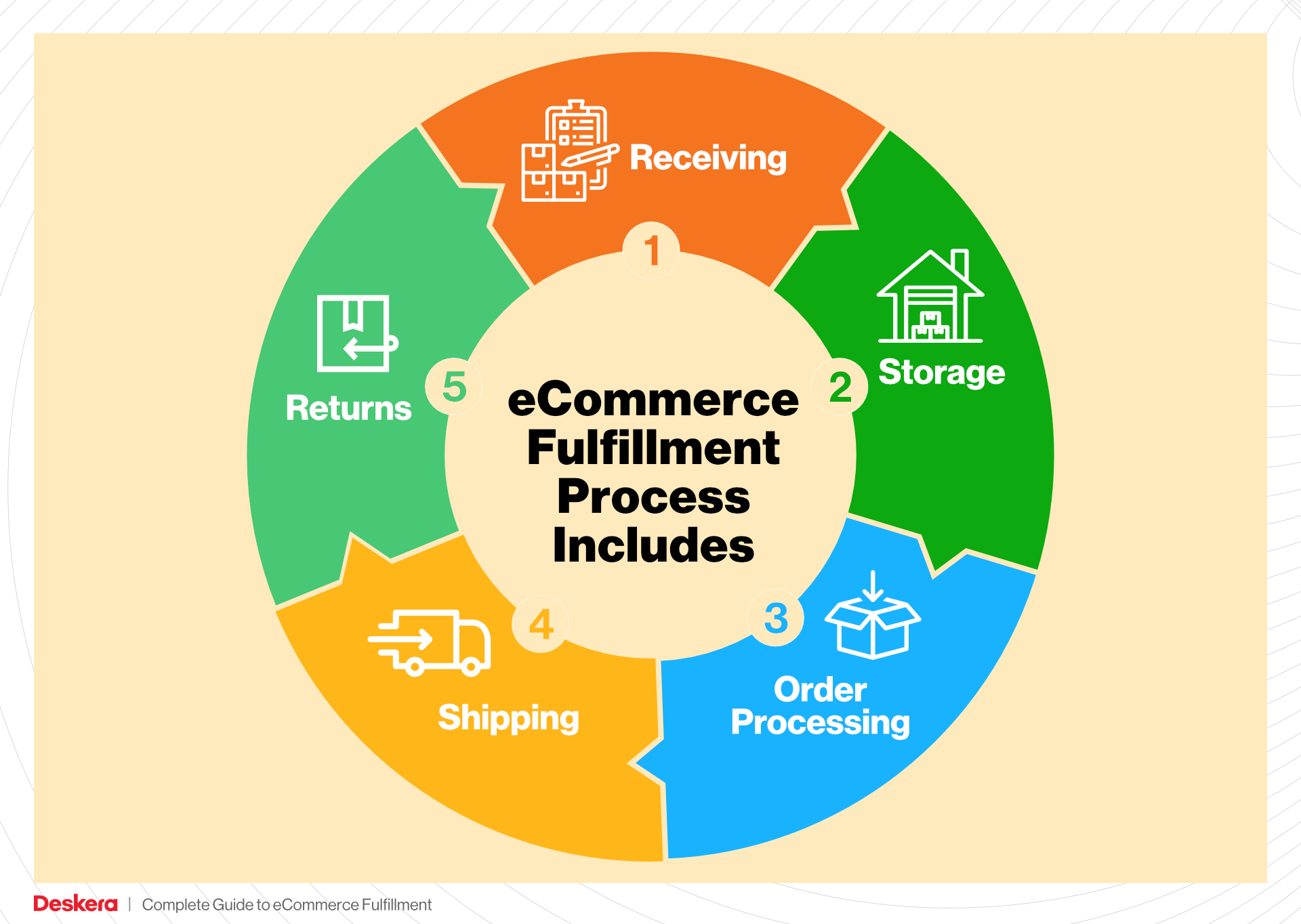
What You’ll Learn In This Guide
- What is E-commerce Fulfillment? An Introduction for Growing Businesses
- The Order Fulfillment Process: From ‘Buy’ Button to Customer’s Door
- Comparing Fulfillment Models: In-House vs. 3PL vs. Dropshipping
- A Deep Dive into Amazon FBA: Pros, Cons, and Who It’s For
- Core Services Offered by Fulfillment Centers
- How to Choose a Fulfillment Partner: A 6-Point Checklist
- Understanding Fulfillment Pricing: A Breakdown of Common Fees
- Frequently Asked Questions (FAQs) about Fulfillment
- Conclusion: Is Outsourcing Fulfillment the Right Move for Your Business?
- Important Disclaimer
The Order Fulfillment Process: From ‘Buy’ Button to Customer’s Door
1. Receiving Inventory
The order fulfillment process begins with the receiving inventory phase, which is crucial for maintaining an efficient supply chain. During this stage, products arrive at the fulfillment center from suppliers or manufacturers. The first step is to process Advance Shipping Notices (ASNs), which provide detailed information about incoming shipments. This ensures that the receiving team is prepared for the specific items that will arrive.
Once the products are received, thorough inventory checks are performed to verify that the quantities and conditions match the shipment documents. This is essential to prevent discrepancies that could lead to stockouts or overages. Following this, the items are entered into the inventory management system using a unique identifier known as a Stock Keeping Unit (SKU). This allows for real-time tracking and efficient management of inventory levels.
Proper receiving procedures are vital as they set the foundation for the entire fulfillment process. Any errors at this stage can ripple through subsequent steps, leading to delays and customer dissatisfaction. A robust receiving system ensures that products are accounted for and ready for storage, ultimately enhancing operational efficiency.
2. Warehouse Storage
After the inventory is received and verified, the next step is warehouse storage. This phase involves organizing and storing products in a manner that maximizes space and minimizes picking errors. Products are stored based on specific criteria, which may include size, weight, or type, and are often categorized using a bin location system. This systematic approach facilitates quick access to items when orders are placed.
Efficient storage is crucial for maintaining a streamlined operation. By optimizing space and organizing products logically, businesses can significantly reduce the time it takes to fulfill orders. Additionally, security measures such as 24/7 surveillance are implemented to protect inventory from theft or damage.
A well-managed warehouse not only improves operational efficiency but also enhances customer satisfaction by ensuring that products are readily available for quick dispatch. This proactive approach to storage helps businesses scale effectively, especially during peak seasons when order volumes may surge.

3. Order Picking
The order picking phase is where the fulfillment process truly begins to take shape. Once a customer places an order, the fulfillment team generates a pick list, which details the items to be retrieved from the warehouse. This list is essential for ensuring accuracy and efficiency during the picking process.
During picking, trained staff or automated systems locate and collect the specified items. Accuracy is paramount here; errors in picking can lead to incorrect shipments, resulting in increased return rates and customer dissatisfaction. To mitigate this risk, many fulfillment centers utilize barcode scanning technology to confirm that the correct items are selected.
Efficient order picking is critical for maintaining a competitive edge in e-commerce. By optimizing this step, businesses can reduce processing times and improve overall customer experience, leading to higher retention rates and positive reviews.
4. Order Packing
Once items are picked, the next step is order packing. This phase involves carefully packaging the products to ensure they arrive at the customer’s door in perfect condition. Proper packing techniques, including the use of protective materials, are employed to safeguard items during transit.
During packing, fulfillment centers often implement packing slips, which serve as a checklist to ensure that all items included in the order are accounted for before sealing the package. Customization options, such as branded packaging or kitting (the process of grouping products together), can also be offered to enhance the customer experience and reinforce brand identity.
Effective packing is crucial not only for protecting products but also for optimizing shipping costs. By using appropriate packaging materials and minimizing excess space, businesses can reduce shipping fees and improve their bottom line. Furthermore, a well-packed order reflects positively on the brand, encouraging repeat purchases.
5. Shipping & Delivery
The final step in the order fulfillment process is shipping and delivery. Once orders are packed, they are handed over to reliable shipping carriers. Establishing strong partnerships with carriers such as USPS, FedEx, or UPS ensures that businesses can offer customers various delivery options, enhancing their overall shopping experience.
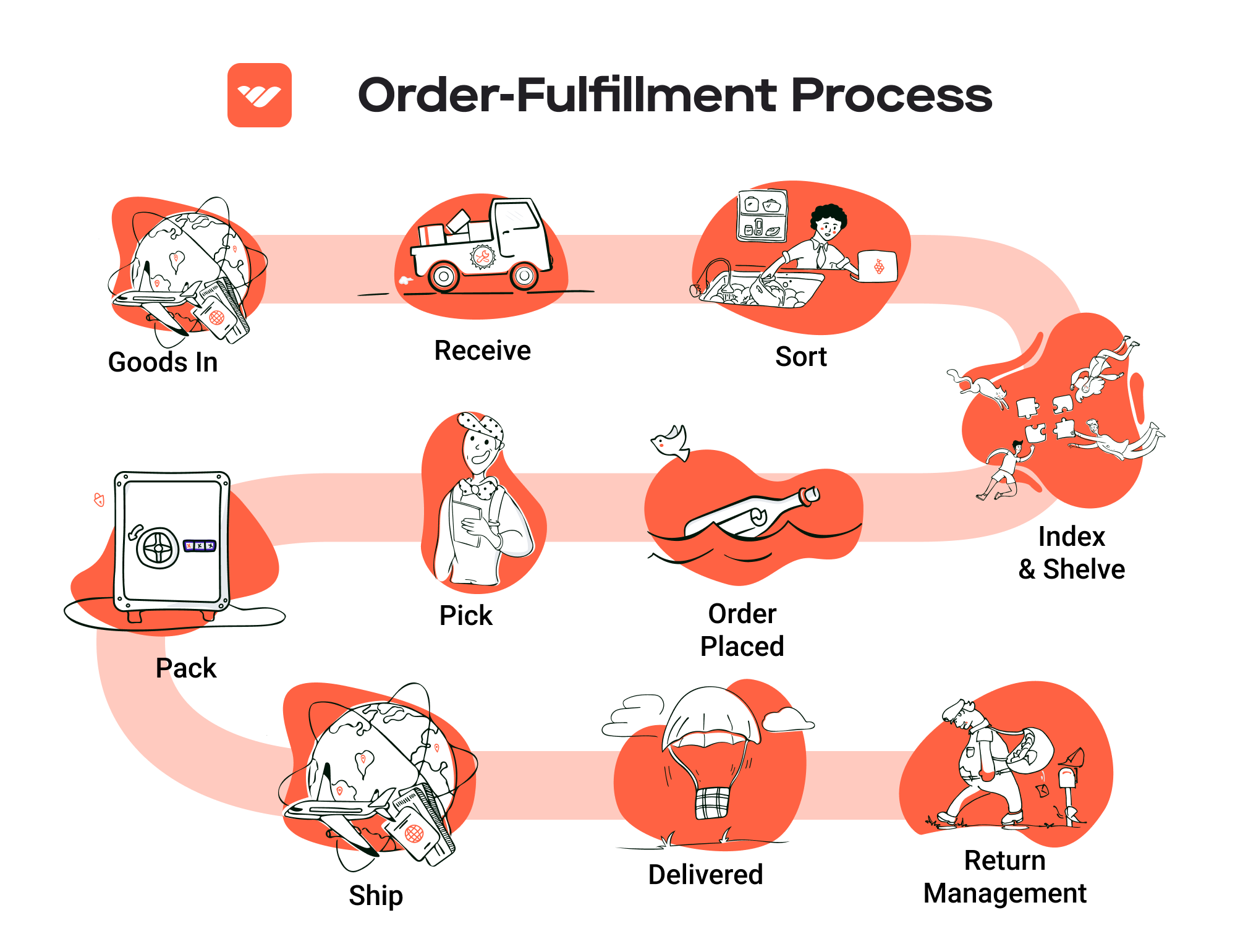
Shipping transparency is vital in this phase. Customers should be able to track their orders in real-time, which helps build trust and keeps them informed about delivery timelines. Effective communication regarding shipping statuses also reduces customer inquiries and improves overall satisfaction.
Timely delivery is a key differentiator in the competitive e-commerce landscape. By ensuring that orders are dispatched quickly and efficiently, businesses can enhance customer loyalty and drive repeat purchases. Overall, a well-executed shipping process is essential for transforming a simple transaction into a positive customer experience, ultimately contributing to long-term growth and success.
Comparing Fulfillment Models: In-House vs. 3PL vs. Dropshipping
Fulfillment Model Comparison
| Model | Who Handles Inventory | Best For (Business Stage) | Key Advantage | Key Disadvantage |
|---|---|---|---|---|
| In-House Fulfillment | The e-commerce business itself | Startups to Small Businesses | Complete control over inventory and operations | Higher overhead costs and scalability issues |
| Third-Party Logistics (3PL) | The 3PL provider | Growing Businesses | Reduced operational burden and faster scaling | Less control over logistics and potential misalignment with brand values |
| Dropshipping | The supplier | New or Low-Volume Businesses | Low startup costs and no inventory management | Lower profit margins and longer shipping times |
In-House Fulfillment
In-house fulfillment is a model where the e-commerce business manages all aspects of order fulfillment, from inventory storage to order processing and shipping. This approach is often favored by startups and small businesses that have a manageable order volume and want to maintain complete control over their inventory and operations. One of the main advantages of in-house fulfillment is the ability to directly oversee the entire process, ensuring that products are stored and handled according to the business’s specific standards. This control can enhance quality assurance and provide a more personalized customer experience.
However, as businesses grow, the limitations of in-house fulfillment become more apparent. Managing fulfillment internally often leads to higher overhead costs, including labor, warehouse space, and inventory management systems. Additionally, scaling operations during peak seasons can be challenging, as businesses must hire temporary staff and potentially invest in additional storage space. This can lead to inefficiencies and increased risk of errors, which can harm customer satisfaction. For businesses with aspirations to scale quickly, in-house fulfillment may not be the most sustainable long-term solution.
Third-Party Logistics (3PL)
Third-party logistics (3PL) is a model where businesses partner with a specialized logistics provider to handle various aspects of fulfillment, including warehousing, order processing, and shipping. This model is ideal for growing businesses that experience increasing order volumes but want to focus on core competencies like marketing and product development rather than logistics. A key advantage of utilizing a 3PL is the ability to leverage their expertise and infrastructure, allowing businesses to scale quickly without the burden of managing logistics in-house.
3PL providers typically offer a range of services, including advanced inventory management systems, real-time tracking, and returns management, which can significantly enhance operational efficiency. They also often have established relationships with shipping carriers, allowing businesses to benefit from lower shipping rates and faster delivery times. However, the primary disadvantage of working with a 3PL is the potential loss of control over the fulfillment process. Businesses may find it challenging to align their brand values with the practices of the 3PL provider, which can lead to inconsistencies in customer experience. Moreover, businesses must ensure they select a reliable 3PL partner with a proven track record to mitigate risks associated with outsourcing logistics.
Dropshipping
Dropshipping is a fulfillment model where the retailer does not hold inventory but instead transfers customer orders and shipment details to a supplier or manufacturer, who then ships the products directly to the customer. This model is particularly attractive for new or low-volume businesses due to its low startup costs and minimal financial risk. Entrepreneurs can launch an e-commerce store without the need for significant upfront investment in inventory, as they only pay for products once they are sold.
The primary advantage of dropshipping is the elimination of inventory management and warehousing concerns. This allows business owners to focus on marketing and sales strategies without worrying about fulfillment logistics. However, dropshipping comes with notable disadvantages, including lower profit margins due to reliance on suppliers and longer shipping times, which can negatively impact customer satisfaction. Additionally, the lack of control over inventory can lead to stockouts or shipping errors, further complicating the customer experience. For businesses considering dropshipping, it’s essential to thoroughly vet suppliers and establish clear communication channels to mitigate potential issues and ensure a smooth fulfillment process.
Conclusion
When considering fulfillment models, e-commerce business owners must evaluate their unique needs, growth ambitions, and operational capabilities. In-house fulfillment offers control but may not scale efficiently. 3PL can provide expertise and scalability, but requires careful partner selection. Dropshipping minimizes risk and investment but can impact profit margins and customer satisfaction. By understanding the strengths and weaknesses of each model, businesses can make informed decisions that align with their growth strategies and operational goals.
A Deep Dive into Amazon FBA: Pros, Cons, and Who It’s For
Understanding Fulfillment by Amazon (FBA)
Fulfillment by Amazon (FBA) is a service provided by Amazon that allows sellers to store their products in Amazon’s fulfillment centers. Amazon takes care of storage, packaging, shipping, and customer service on behalf of the seller. This service enables sellers to leverage Amazon’s vast logistics network and customer trust, helping them scale their businesses effectively.
How FBA Works
- Product Listing: Sellers create listings for their products on the Amazon marketplace.
- Inventory Shipment: Sellers send their products to Amazon’s fulfillment centers. They can choose to send inventory to one or multiple centers based on Amazon’s recommendations.
- Storage: Once the inventory arrives at the fulfillment center, Amazon stores it until it is sold.
- Order Processing: When a customer places an order, Amazon handles the picking, packing, and shipping of the product directly to the customer.
- Customer Service: Amazon manages all customer service inquiries and handles returns on behalf of the seller.
- Payments: Sellers receive payments for their sales after deducting Amazon’s fees.
This streamlined process allows sellers to focus on product development and marketing while Amazon manages the logistics.
Pros of Using FBA
1. Prime Eligibility
One of the most significant advantages of FBA is that products become eligible for Amazon Prime. This means that Prime members can benefit from free two-day shipping, which enhances the attractiveness of your products and can lead to increased sales.
2. Customer Trust
Amazon is a well-established and trusted platform among consumers. By using FBA, sellers can leverage this trust, as customers often prefer products fulfilled by Amazon due to perceived reliability in shipping and customer service.
3. Multi-Channel Fulfillment
FBA isn’t limited to just Amazon sales. Sellers can utilize FBA to fulfill orders from other sales channels, such as their own websites or other e-commerce platforms. This multi-channel fulfillment capability allows businesses to streamline their logistics, ensuring consistent and efficient order processing across various sales channels.
4. Simplified Logistics
FBA takes the complexity out of logistics. Sellers do not need to worry about warehousing, packing, or shipping their products. Amazon handles these processes, allowing sellers to focus on other essential aspects of their business, such as marketing and customer engagement.
5. Scalability
FBA is designed to grow with your business. Whether you’re a small seller just starting or a large enterprise, FBA can accommodate your needs. As order volumes increase, Amazon’s infrastructure can handle the increased demand without the seller needing to invest in additional resources.
Cons of Using FBA
1. High Fees
While FBA offers numerous benefits, it comes with costs. Amazon charges various fees, including storage fees, fulfillment fees, and additional costs for long-term storage. These fees can add up quickly, eating into profit margins, especially for sellers with lower-priced items or slow-moving inventory.
2. Strict Inventory Rules
Sellers must adhere to Amazon’s strict inventory rules, including guidelines on how to package and label products. Failure to comply can result in additional fees or inventory being returned. This level of control can be frustrating for sellers accustomed to managing their inventory independently.
3. Commingling Risks
FBA allows for inventory commingling, where products from multiple sellers are stored together. This can lead to issues if customers receive the wrong item or if there are quality concerns. Sellers may face challenges in tracking their specific inventory, which can complicate returns and customer service.
4. Limited Control
By using FBA, sellers relinquish some control over their fulfillment process. While Amazon’s systems are efficient, sellers may find that they cannot respond as quickly to issues that arise, such as inventory shortages or shipping delays.
5. Dependency on Amazon
Sellers relying heavily on FBA may become overly dependent on Amazon for their sales. Changes in Amazon’s policies, fees, or marketplace dynamics can significantly impact a seller’s business, making it crucial to diversify sales channels.
Who is FBA Best For?
FBA is particularly well-suited for:
- Small to Medium-Sized Sellers: Those who lack the resources to manage their own logistics and want to focus on growth.
- E-commerce Entrepreneurs: New sellers looking to enter the market quickly and leverage Amazon’s vast customer base.
- Brands with High Sales Volume: Sellers who anticipate high sales volumes and can absorb the associated fees while benefiting from increased visibility and trust.
- Businesses Seeking Multi-Channel Fulfillment: Brands that sell on multiple platforms and want a streamlined logistics solution.
In conclusion, FBA can be a powerful tool for scaling e-commerce businesses, but it is essential to weigh the benefits against the potential downsides. By understanding how FBA works and who it serves best, sellers can make informed decisions that align with their business goals and operational needs.
Core Services Offered by Fulfillment Centers
Inventory Management & Warehousing
Inventory management and warehousing are foundational services provided by fulfillment centers, designed to streamline the storage and tracking of products. This process begins with receiving products, where the fulfillment center logs incoming inventory, checks for accuracy, and ensures that items are in good condition. Advanced inventory tracking systems are employed to monitor stock levels in real-time, allowing businesses to maintain optimal inventory levels and prevent stockouts.
Benefits:
1. Efficiency: By centralizing storage in a fulfillment center, businesses can minimize the complexities of managing multiple storage locations. This leads to reduced overhead costs and improved operational efficiency.
2. Visibility: Real-time inventory tracking provides e-commerce businesses with the ability to monitor stock levels, manage SKUs effectively, and make informed decisions about restocking. This visibility is crucial for avoiding excess inventory and associated costs.
3. Security: Fulfillment centers typically implement stringent security measures, including surveillance and controlled access, ensuring that inventory is protected from theft or damage.
Pick and Pack Services
The pick and pack process involves selecting items from inventory and preparing them for shipment. Fulfillment centers utilize organized systems to ensure that orders are processed accurately and efficiently. Once an order is received, the fulfillment center’s team picks the specified items, packs them securely, and prepares them for dispatch.
Benefits:
1. Accuracy: A well-defined pick and pack process minimizes errors, ensuring that customers receive the correct items. This accuracy enhances customer satisfaction and reduces the cost of returns due to incorrect orders.
2. Speed: Fulfillment centers often have optimized workflows that allow for same-day order processing. Fast and reliable fulfillment is critical for e-commerce businesses looking to meet customer expectations for quick delivery.
3. Customization: Many fulfillment centers offer custom packing options, such as branded packaging or promotional materials, which can enhance the customer experience and reinforce brand identity.
Kitting and Assembly
Kitting and assembly services involve grouping individual items into a single package or kit, often customized for marketing or promotional purposes. This could include assembling subscription boxes, creating gift sets, or bundling related products together. Fulfillment centers have the expertise and resources to efficiently handle these specialized tasks.
Benefits:
1. Enhanced Customer Experience: By offering kitting and assembly services, businesses can provide unique product offerings that attract customers. Custom kits can create a memorable unboxing experience and encourage repeat purchases.
2. Cost Efficiency: Outsourcing kitting and assembly to a fulfillment center can save businesses time and labor costs. This allows internal teams to focus on core business activities such as marketing and sales.
3. Scalability: As e-commerce businesses grow, the ability to quickly scale kitting operations is essential. Fulfillment centers can adapt to increased demand without the need for businesses to invest in additional resources or infrastructure.
Returns Management (Reverse Logistics)
Returns management, or reverse logistics, is a crucial service that ensures a seamless process for handling product returns. Fulfillment centers streamline this process by managing the return of goods, inspecting them for damage, restocking items, and processing refunds efficiently.
Benefits:
1. Customer Satisfaction: A hassle-free returns process can significantly enhance customer satisfaction. When customers feel confident that they can return products easily, they are more likely to make purchases.
2. Cost Reduction: Efficient returns management reduces overhead costs associated with handling returns in-house. Fulfillment centers can process returns faster, minimizing the time products spend in reverse logistics and ensuring they are quickly restocked.
3. Data Insights: Analyzing return data can provide valuable insights into product performance and customer preferences. This information can help e-commerce businesses make informed decisions about product offerings and marketing strategies.
By leveraging the core services offered by fulfillment centers—inventory management and warehousing, pick and pack services, kitting and assembly, and returns management—e-commerce businesses can enhance their operational efficiency, improve customer satisfaction, and ultimately drive growth. These services enable businesses to focus on their core competencies while leaving the complexities of logistics to expert fulfillment partners.
How to Choose a Fulfillment Partner: A 6-Point Checklist
Location & Warehouse Network
Importance:
The geographical location of your fulfillment partner’s warehouses is crucial for ensuring timely deliveries and reducing shipping costs. A strategically placed warehouse network can help you reach your customers faster, which is essential for maintaining a competitive edge in e-commerce.
Questions to Ask:
– How many warehouses do you operate, and where are they located?
– Can you provide shipping coverage maps to show delivery times to key markets?
– Do you have any warehouses in regions that are important for my target audience?
– What is your policy for expanding warehouse locations as my business grows?
Technology & Integrations
Importance:
In today’s digital age, a fulfillment partner’s technology capabilities can make or break your operations. Seamless integration with your e-commerce platform (like Shopify, WooCommerce, or Amazon) is vital for real-time inventory tracking, order management, and customer communication.
Questions to Ask:
– What technology platform do you use for inventory management, and how does it integrate with my existing systems?
– Can you provide real-time tracking for both my business and my customers?
– How do you handle data security and privacy?
– Are there additional costs associated with technology integrations?
Specializations (e.g., Cold Storage, Oversized Items)
Importance:
Different products have unique storage and handling requirements. If your business deals in specialized items such as perishables, hazardous materials, or oversized goods, finding a fulfillment partner with the necessary expertise and facilities is crucial for maintaining product integrity and compliance.
Questions to Ask:
– What specific types of products do you specialize in handling?
– Do you have the capability to manage cold storage or specialized handling for my products?
– How do you ensure compliance with industry regulations related to my product types?
– Can you accommodate custom packaging or kitting for specialized products?
Scalability & Capacity
Importance:
As your business grows, your fulfillment needs will evolve. A good fulfillment partner should have the capacity to scale operations efficiently without compromising service quality. This flexibility is essential for managing seasonal demand fluctuations and unexpected growth.
Questions to Ask:
– What is your current capacity for order fulfillment, and how do you manage peak seasons?
– How quickly can you scale operations in response to my business growth?
– Do you have experience working with businesses that have undergone rapid growth?
– What are your protocols for maintaining service levels during high-demand periods?
Pricing and Contracts
Importance:
Understanding pricing structures and contract terms is essential to avoid unexpected costs that can erode your profit margins. Look for transparency in pricing, flexibility in contract terms, and the absence of hidden fees.
Questions to Ask:
– What pricing model do you use (e.g., pay-as-you-go, tiered pricing, flat fees)?
– Are there any setup fees or minimum order requirements?
– What happens if my order volume fluctuates significantly?
– Can you provide a detailed breakdown of all potential costs involved in the fulfillment process?
Customer Support & Reviews
Importance:
Reliable customer support is critical for addressing any operational issues that may arise. Additionally, reviews and testimonials can provide insights into the partner’s reliability, service quality, and responsiveness.
Questions to Ask:
– What type of customer support do you offer (e.g., dedicated account managers, 24/7 support)?
– How do you handle disputes or issues related to order fulfillment?
– Can you provide references or case studies from businesses similar to mine?
– What is your average response time for support inquiries?
Conclusion
Choosing the right fulfillment partner is a pivotal decision that can significantly impact your e-commerce business’s success. By following this checklist and asking the right questions, you can ensure that you select a 3PL provider that aligns with your operational needs and growth objectives. A strategic partnership in fulfillment can empower you to focus on scaling your sales while ensuring that your logistics are handled efficiently and effectively.
Understanding Fulfillment Pricing: A Breakdown of Common Fees
Initial Setup Fees
Initial setup fees are one-time charges that may be incurred when you first partner with a fulfillment provider. These fees cover the administrative costs associated with onboarding your business, including inventory assessment, system integration, and account setup. Depending on the provider, these costs can vary significantly. Some fulfillment centers may waive these fees to attract new clients, while others may charge a flat rate or base it on the complexity of your needs.
When evaluating setup fees, consider the following:
– Complexity of Integration: If your e-commerce platform requires custom integrations, expect higher fees.
– Inventory Assessment: Some providers charge based on the volume or type of products you are bringing into their system.
– Contract Terms: Review the terms of any agreements regarding long-term commitments, as they may impact initial costs.
Receiving Fees
Receiving fees are charged when your inventory arrives at the fulfillment center. This fee typically covers the labor involved in unloading, inspecting, and logging your products into the system. The calculation of receiving fees can depend on several factors:
- Volume of Inventory: Many fulfillment centers charge per pallet or per item received. Higher volumes may qualify for discounts.
- Condition of Goods: If additional handling is required due to damaged goods or discrepancies, extra charges may apply.
- Advance Shipping Notices (ASN): Providing timely and accurate ASNs can help streamline the receiving process and potentially reduce fees.
Storage Fees (per pallet/bin)
Storage fees are recurring charges for keeping your inventory at the fulfillment center. These fees are typically calculated on a monthly basis and can vary based on the amount of space your inventory occupies. Key factors influencing storage fees include:
- Storage Type: Providers may charge per pallet or per bin. Understanding how your products are stored will help you estimate costs more accurately.
- Seasonal Fluctuations: Some fulfillment centers adjust rates based on seasonal demand. If you have products that see significant seasonal sales, consider how that may impact your storage fees.
- Long-Term Storage Costs: Be aware that some providers impose additional fees for inventory that remains in storage beyond a certain period, which can add to your costs if you have slow-moving items.
Pick & Pack Fees (per item/order)
Pick and pack fees are charged for the labor involved in selecting items from storage and preparing them for shipment. These fees can be structured in several ways:
- Per Item or Per Order: Some providers charge a flat fee per item picked, while others may charge a single fee for each order, regardless of the number of items.
- Kitting and Customization: If you require special packaging, kitting, or additional services such as gift wrapping, these may incur extra charges.
- Order Complexity: More complex orders that require additional handling may also lead to higher fees, so it’s important to understand how your specific needs will be priced.
Shipping Fees
Shipping fees are one of the most variable costs in fulfillment pricing and can significantly impact your overall expenses. These fees cover the cost of transporting your products to customers and can be influenced by several factors:
- Carrier Selection: Different carriers (e.g., USPS, FedEx, UPS) have varying rates based on delivery speed and service levels. Providers often negotiate discounted rates with carriers, which can affect your costs.
- Destination: Shipping to remote or international locations may incur higher fees. Understanding your customer base can help you anticipate these costs.
- Shipping Method: Offering multiple shipping options (standard, expedited, same-day) can affect pricing. Consider how the choices you provide to customers impact your fulfillment costs.
Tips for Getting an Accurate Quote
To obtain an accurate quote from a fulfillment provider, follow these guidelines:
- Be Transparent: Provide detailed information about your business model, including expected order volumes, types of products, and any special handling requirements.
- Compare Providers: Request quotes from multiple fulfillment centers to understand the range of fees and services offered.
- Ask About Hidden Fees: Inquire about potential hidden costs, such as long-term storage fees or additional charges for returns.
- Consider Flexibility: Choose a provider that can accommodate fluctuations in your order volume without incurring steep penalties.
- Review Contract Terms: Understand the terms of service, including any commitments or penalties for early termination, to ensure alignment with your business growth strategy.
By carefully assessing fulfillment pricing models and following these tips, you can make informed decisions that enhance your e-commerce operations while keeping costs manageable.
Frequently Asked Questions (FAQs) about Fulfillment
1. What is a fulfillment fund?
A fulfillment fund is a financial resource allocated specifically for the costs associated with order fulfillment in e-commerce. This may include expenses related to warehousing, packaging, shipping, and returns management. Establishing a fulfillment fund helps businesses manage cash flow effectively, particularly during peak sales periods or when launching new products.
2. What’s the difference between a warehouse and a fulfillment center?
A warehouse primarily serves as a storage facility for goods, focusing on inventory management. In contrast, a fulfillment center is designed to handle the entire order fulfillment process, which includes receiving inventory, picking and packing orders, and shipping them directly to customers. Fulfillment centers often incorporate advanced technology and logistics capabilities to streamline these processes.
3. What is a 3PL (Third-Party Logistics)?
A Third-Party Logistics (3PL) provider is a company that offers logistics services, including warehousing, order fulfillment, shipping, and returns management, on behalf of another business. Utilizing a 3PL allows e-commerce businesses to outsource their logistics functions, enabling them to focus on core activities like marketing and product development while leveraging the expertise and infrastructure of the 3PL.
4. How much do fulfillment services cost?
The cost of fulfillment services can vary widely depending on factors such as the volume of orders, the complexity of the fulfillment process, and the specific services required. Common pricing models include per-order fees, storage fees, and pick-and-pack fees. It’s essential to request quotes from multiple providers to understand the costs and find a solution that fits your budget and business needs.
5. When should I consider outsourcing my fulfillment?
You should consider outsourcing fulfillment if you experience consistent order volume with expected growth, face challenges in managing inventory or storage space, desire faster delivery times, or struggle with returns management. Outsourcing can help reduce overhead costs, improve efficiency, and enhance customer satisfaction through quicker deliveries.
6. What technologies are essential for effective fulfillment?
Key technologies for effective fulfillment include inventory management systems (IMS), order management systems (OMS), and customer relationship management (CRM) software. These systems help track inventory levels, manage order processing, and facilitate communication between your e-commerce platform and fulfillment provider, ensuring a seamless fulfillment experience.
7. How do I choose the right fulfillment partner?
Selecting the right fulfillment partner involves assessing their technology integration capabilities, warehousing network, customer support services, shrinkage policies, and flexibility. Ensure they can scale with your business needs and have a proven track record of reliability and customer satisfaction.
8. What is the typical order fulfillment process?
The typical order fulfillment process includes several key stages:
1. Receiving: Inventory is received and checked for accuracy.
2. Storage: Products are stored in an organized manner within the warehouse.
3. Picking: Orders are picked based on customer requests.
4. Packing: Items are packed securely for shipment.
5. Shipping: Orders are dispatched via selected carriers.
6. Returns Management: Handling returns efficiently to maintain customer satisfaction.
9. How can I improve my fulfillment efficiency?
Improving fulfillment efficiency can be achieved through several strategies:
– Implementing advanced inventory management systems for real-time tracking.
– Optimizing warehouse layout to minimize picking times.
– Utilizing automation for order processing and packing.
– Training staff regularly to ensure they are familiar with best practices.
– Analyzing fulfillment metrics to identify areas for improvement.
10. What are the benefits of using a fulfillment service?
Using a fulfillment service offers numerous benefits, including:
– Cost savings: Reduced overhead costs associated with maintaining your own warehouse.
– Scalability: Ability to scale operations quickly during peak seasons.
– Focus on core business: Freeing up time to concentrate on marketing and product development.
– Improved customer satisfaction: Faster and more reliable shipping leading to happier customers.
– Expertise: Access to logistics professionals who can optimize your fulfillment process.
Conclusion: Is Outsourcing Fulfillment the Right Move for Your Business?
Key Benefits of Outsourcing Fulfillment
Outsourcing your fulfillment can be a transformative decision for your e-commerce business, offering significant advantages that can propel growth and enhance customer satisfaction. One of the primary benefits is time savings; by delegating order processing, inventory management, and shipping logistics to a specialized fulfillment service, you can refocus your energies on core business activities such as marketing, product development, and customer engagement. This shift not only streamlines operations but also allows for more strategic decision-making.
Scalability is another critical factor. As your business grows, so do the complexities of order fulfillment. Partnering with a fulfillment provider allows you to scale operations seamlessly, accommodating fluctuating order volumes without the need for substantial investments in infrastructure or personnel. This flexibility is particularly valuable during peak sales periods or when launching new products.
Moreover, leveraging the expertise of a fulfillment partner means you benefit from industry best practices, advanced technologies, and a network of established carrier relationships. This expertise translates into improved delivery speed, reduced shipping costs, and enhanced customer experiences—elements that are vital for retaining competitive advantage in the e-commerce landscape.
Choosing the Right Partner for Growth
However, the effectiveness of outsourcing hinges on selecting the right fulfillment partner. Look for a provider that aligns with your business goals, offers transparent communication, and possesses a strong track record of reliability and customer satisfaction. Their ability to integrate seamlessly with your e-commerce platforms and provide customized solutions is equally important.
Take Action Today
As you consider whether outsourcing fulfillment is the right move for your business, take a moment to audit your current shipping and fulfillment processes. Identify pain points, inefficiencies, and areas for improvement. This assessment will not only clarify your needs but also position you to make an informed decision about partnering with a fulfillment service that can drive your business forward. Embrace the opportunity to optimize your operations and unlock your business’s full potential.
Important Disclaimer
⚠️ Important Disclaimer
The information in this guide is for educational purposes. Fulfillment services, pricing, and platform features change frequently. Always conduct your own due diligence and consult with providers directly before making business decisions.

